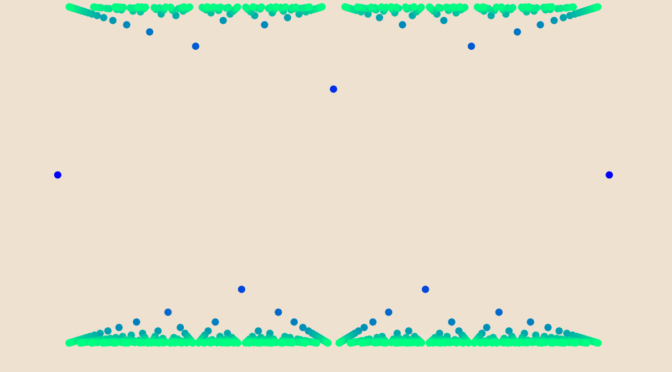According to the extreme value theorem, a continuous real-valued function \(f\) in the closed and bounded interval \([a,b]\) must attain a maximum and a minimum, each at least once.
Let’s see what can happen for non-continuous functions. We consider below maps defined on \([0,1]\).
First let’s look at \[
f(x)=\begin{cases}
x &\text{ if } x \in (0,1)\\
1/2 &\text{otherwise}
\end{cases}\] \(f\) is bounded on \([0,1]\), continuous on the interval \((0,1)\) but neither at \(0\) nor at \(1\). The infimum of \(f\) is \(0\), its supremum \(1\), and \(f\) doesn’t attain those values. However, for \(0 < a < b < 1\), \(f\) attains its supremum and infimum on \([a,b]\) as \(f\) is continuous on this interval.
Bounded function that doesn’t attain its infimum and supremum on all \([a,b] \subseteq [0,1]\)
The function \(g\) defined on \([0,1]\) by \[
g(x)=\begin{cases}
0 & \text{ if } x \notin \mathbb Q \text{ or if } x = 0\\
\frac{(-1)^q (q-1)}{q} & \text{ if } x = \frac{p}{q} \neq 0 \text{, with } p, q \text{ relatively prime}
\end{cases}\] is bounded, as for \(x \in \mathbb Q \cap [0,1]\) we have \[
\left\vert g(x) \right\vert < 1.\] Hence \(g\) takes values in the interval \([-1,1]\). We prove that the infimum of \(g\) is \(-1\) and its supremum \(1\) on all intervals \([a,b]\) with \(0 < a < b <1\). Consider \(\varepsilon > 0\) and an odd prime \(q\) such that \[
q > \max(\frac{1}{\varepsilon}, \frac{1}{b-a}).\] This is possible as there are infinitely many prime numbers. By the pigeonhole principle and as \(0 < \frac{1}{q} < b-a\), there exists a natural number \(p\) such that \(\frac{p}{q} \in (a,b)\). We have \[
-1 < g \left(\frac{p}{q} \right) = \frac{(-1)^q (q-1)}{q} = - \frac{q-1}{q} <-1 +\varepsilon\] as \(q\) is supposed to be an odd prime with \(q > \frac{1}{\varepsilon}\). This proves that the infimum of \(g\) is \(-1\). By similar arguments, one can prove that the supremum of \(g\) on \([a,b]\) is \(1\).

